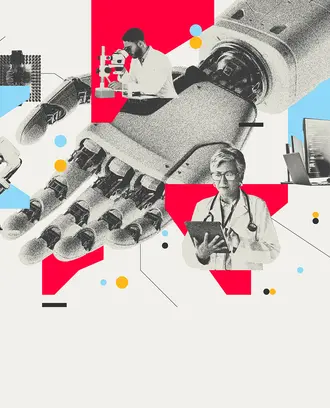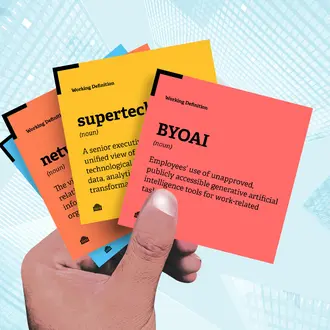Credit: Harry Campbell / theispot.com
As executives continue to respond to the business challenges posed by COVID-19, they must address the parallel needs to remain resilient amid the pandemic while continuing to plan for the future.
These recent insights from MIT Sloan Management Review will help executives effectively lead amid the chaos, prepare supply chains for the road ahead, and plan for investments in enterprise architecture, digital ecosystems, and artificial intelligence.
The Overlooked Key to Leading Through Chaos
Today’s businesses face ever-increasing rates of change in technology, consumer behavior, and economic uncertainty. That makes it even more critical for leadership to embrace sensemaking as a way to thoroughly understand complex circumstances in order to take the best action.
Many of the hallmark traits of sensemaking — including curiosity, creativity, and engaging diverse viewpoints — are often undervalued among leaders as well as hiring managers. This can leave executives and their teams poorly equipped for nimble decision-making when leading through chaos, MIT Sloan professor Deborah Ancona writes.
To shift gears, firms can embed sensemaking into organizational structure through a three-step process.
- Learn. Pull together relevant stakeholders to seek new ideas, perspectives, and practices. Get out of the office if necessary. Pixar sent the Finding Nemo team scuba diving to see tropical fish in their natural environment.
- Map. Create a report, image, or product mock-up to capture what was learned. Be sure to note any assumptions that changed over the course of data collection.
- Experiment. Try out solutions, update the map, and adopt new approaches. Sensemaking should be a call to action, the authors note, and not an end in itself.
Data, Not Digitalization, Transforms the Post-Pandemic Supply Chain
Organizations made considerable investments in recent years to digitalize supply chain management. Then, to paraphrase boxer Mike Tyson, they got punched in the mouth by COVID-19.
According to MIT Sloan researcher Michael Schrage, these organizations learned the hard way that data drives successful supply chain transformation, not just digitalization. Supply chain leaders needed data they hadn’t accessed before, lacked the tools to gain actionable insight, and had focused on internal metrics that didn’t account for downstream assessment needs such as worker safety or supplier viability.
For supply chain leaders hoping to turn COVID-19 disruption into an opportunity for transformation, Schrage recommends asking the following five questions.
- Does data governance make data more accessible throughout the enterprise, or does it replace legacy inefficiencies?
- How are you measuring operational visibility, how clean and accessible is this data, and how can supply chain managers get whatever data is missing?
- Does your level of transparency into supply chain performance meet customers’ expectations given current circumstances?
- How do you encourage visibility, especially with key suppliers outside the organization, and leverage visibility in order to build trust?
- How will a commitment to visibility and transparency align with the adoption of automation?
Why You — Yes, You — Need Enterprise Architecture
Many businesses were designed around product verticals that are independent of the rest of the organization. This can lead to scenarios where each product comes with its own payment processing system, when in reality a single team could design a single system for all products.
Breaking down these silos means evolving into a digital company to embrace enterprise architecture, writes MIT Sloan researcher Jeanne Ross. This is an evolutionary process, not a rip-and-replace solution, and it consists of three main principles.
- Break processes and products into reusable components. This helps organizations use data more effectively and respond to business opportunities faster.
- Empower cross-functional teams. Instead of managing people, processes, and technology separately, shift the model so that employees are responsible for the processes and technologies for each component.
- Let components influence strategy. As teams develop components, they will learn what customers want and what technology can do. This enables strategy to become a bottom-up exercise.
Ross cites the example of used car retailer CarMax, which has 30 teams building the components of its in-person, at-home, and online business channels. Teams regularly share their findings, which leadership uses to refine strategic planning. This flexibility enabled the company to roll out a contactless, curbside buying experience in response to COVID-19 in just two weeks.
Driving Growth in Digital Ecosystems
In today’s economy, enterprises are more likely to achieve greater revenue growth and profit margins when they can create “one-stop shopping” destinations for their customers, according to survey data from MIT Sloan researchers Ina M. Sebastian, Stephanie L. Woerner, and Peter Weill. This is especially true in the manufacturing, services, and retail/hospitality industries.
Driving growth in digital ecosystems doesn’t happen overnight, but there are six key characteristics of the companies that get it right.
- Distinction. Whether it’s a trusted brand, a lower price point, or an excellent customer experience, a successful digital ecosystem should stand out.
- Organization. Companies and their partners must reorganize at least part of their operating models to support a digital ecosystem. The next steps: eliminate silos, embrace agility, and leverage data.
- Openness. In both B2B and B2C platforms, building connections using APIs makes it easier to share core capabilities and, as a result, scale digital partnerships.
- Joint goals. All participants in a digital ecosystem should agree on a shared vision for value creation, service offerings, and data governance.
- Shared benefits. An ecosystem supports all participants through benefits such as revenue, engagement, visibility, a broader customer base, and complementary product offerings.
- Information guidelines. Data is valuable currency in a digital ecosystem. Companies need to set clear guidelines about what information is shared, and how.
Redefining AI Leadership in the C-Suite
Technology executives often take the lead on artificial intelligence initiatives, but MIT fellow Thomas H. Davenport argues that the CFO can have a significant impact on AI strategy and adoption. There are two key reasons that forward-thinking companies are redefining AI leadership in the C-Suite to give CFOs more of a say.
First, AI can perform many finance functions, including reporting, invoicing, auditing, procurement, and even forecasting. AI is poised to replace outsourcing as a way to achieve productivity. It is also helping organizations adapt to the COVID-19 economy by developing models that better predict product demand or minimize cash outflows. The CFO can emerge as an advocate for AI — and set an example for others in the C-suite — by establishing an education initiative, creating hybrid roles for AI and finance, or creating an AI center of excellence.
Second, businesses are making significant investments in AI, and they typically realize a return on that investment in less than two years. Here, the CFO can take on a role similar to a venture capital partner by reviewing proposals, moving systems into deployment, assessing value after implementation, and otherwise removing obstacles to success. This can include becoming an executive sponsor for certain projects that are relevant to the finance function or need a push to achieve high ROI.



